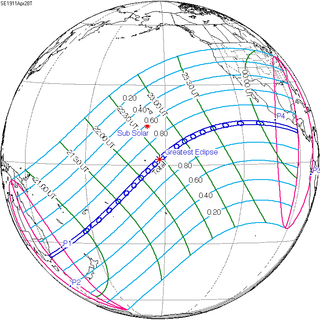A total solar eclipse occurred on 28 April 1911.[1][2][3] A solar eclipse occurs when the Moon passes between Earth and the Sun, thereby totally or partly obscuring the image of the Sun for a viewer on Earth. A total solar eclipse occurs when the Moon's apparent diameter is larger than the Sun's, blocking all direct sunlight, turning day into darkness. Totality occurs in a narrow path across Earth's surface, with the partial solar eclipse visible over a surrounding region thousands of kilometres wide. Totality was visible from southeastern tip of Australia, Tonga, American Samoa and Cook Islands. Places west of International Date Line witnessed the eclipse on Saturday 29 April 1911.
| Solar eclipse of April 28, 1911 | |
|---|---|
| Type of eclipse | |
| Nature | Total |
| Gamma | −0.2294 |
| Magnitude | 1.0562 |
| Maximum eclipse | |
| Duration | 297 s (4 min 57 s) |
| Coordinates | 1°54′N 151°54′W / 1.9°N 151.9°W |
| Max. width of band | 190 km (120 mi) |
| Times (UTC) | |
| Greatest eclipse | 22:27:22 |
| References | |
| Saros | 127 (52 of 82) |
| Catalog # (SE5000) | 9306 |
Observations
A team of Stonyhurst College, England and Saint Ignatius' College, Riverview, New South Wales made observations in Vavaʻu Islands, Tonga. Members of Stonyhurst College departed from Tilbury, England by ship on February 3 and arrived in Sydney on March 16. The team later departed from Sydney on March 25 and arrived in Vavaʻu on April 2. All the instruments were shipped ashore on April 5. The weather was clear for the next few days, but heavy rain showers fell almost every day starting from April 10. The southeast wind starting on April 26 brought thick and large cirrus clouds. On April 28, one day before the eclipse, there were many clouds, which lasted until the morning of April 29. On April 29, the eclipse day, the sky cleared before the first contact (beginning of the partial phase). Afterwards, some cumulus clouds passed through at first, and the weather remained relatively good. During the totality, weather conditions were good in Neiafu, but some areas about 2 miles (3.2 km) away were affected by cirrostratus clouds, and the sun was not visible until 90 seconds before the third contact (end of the total phase). During the eclipse, there was almost no sound on the island except the chirping of crickets, because the government told the local people to keep quiet and not to light fires to avoid creating smoke and disturbing the observations. The team shipped the instruments back on May 2, and the team members departed the island on May 4. They first arrived in Suva, capital of the Colony of Fiji on May 6, and departed again on May 11 and arrived in Sydney on May 17. The British in charge boarded the ship with the instruments leaving Sydney on June 10 and arriving in Tilbury on July 23.[4]
Related eclipses
Solar eclipses 1910–1913
This eclipse is a member of a semester series. An eclipse in a semester series of solar eclipses repeats approximately every 177 days and 4 hours (a semester) at alternating nodes of the Moon's orbit.[5]
| Solar eclipse series sets from 1910 to 1913 | ||||
|---|---|---|---|---|
| Ascending node | Descending node | |||
| 117 | May 9, 1910 Total | 122 | November 2, 1910 Partial | |
| 127 | April 28, 1911 Total | 132 | October 22, 1911 Annular | |
| 137 | April 17, 1912 Hybrid | 142 | October 10, 1912 Total | |
| 147 | April 6, 1913 Partial | 152 | September 30, 1913 Partial | |
Saros 127
It is a part of Saros cycle 127, repeating every 18 years, 11 days, containing 82 events. The series started with partial solar eclipse on October 10, 991 AD. It contains total eclipses from May 14, 1352 through August 15, 2091. There are no annular eclipses in this series. The series ends at member 82 as a partial eclipse on March 21, 2452. The longest duration of totality was 5 minutes, 40 seconds on August 30, 1532. All eclipses in this series occurs at the Moon’s ascending node.[6]
| Series members 52–68 occur between 1901 and 2200 | ||
|---|---|---|
| 52 | 53 | 54 |
 April 28, 1911 |  May 9, 1929 |  May 20, 1947 |
| 55 | 56 | 57 |
 May 30, 1965 |  June 11, 1983 |  June 21, 2001 |
| 58 | 59 | 60 |
 July 2, 2019 |  July 13, 2037 |  July 24, 2055 |
| 61 | 62 | 63 |
 August 3, 2073 |  August 15, 2091 | August 26, 2109 (Partial) |
| 64 | 65 | 66 |
| September 6, 2127 (Partial | September 16, 2145 (Partial) | September 28, 2163 (Partial) |
| 67 | 68 | |
| October 8, 2181 (Partial) | October 19, 2199 (Partial) | |
See also
Notes
References
- NASA graphics
- Report on the total solar eclipse of 1911, April 28 Tonga Island, South Pacific
